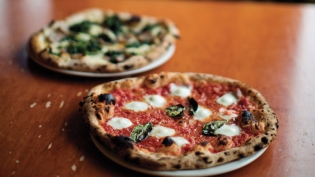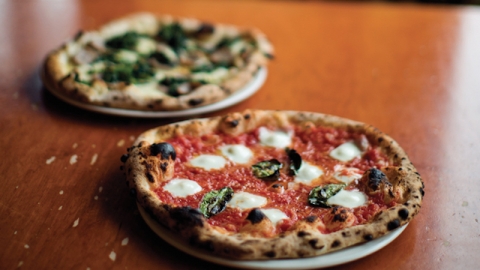Seasonality is Key to Pizza-Making at Piccolo Forno
When your childhood summers are spent behind the scenes of your uncle’s pizzeria-restaurant-bar in Tuscany, Italy, you’re probably not going to opt out of the family business.
Today, Domenic Branduzzi — owner, operator, and self-titled “jack of all trades” at Piccolo Forno for 10 years and counting — considers himself a pizzaiolo, first and foremost. He’s had no formal culinary training, he says, aside from “having a general love of food” and growing up working alongside his mother, a chef, and his dad, a baker. For the restaurant’s chefs, making Branduzzi’s signature pizza dough is a “straightforward” process: flour, water, yeast, and salt; a 24-hour minimum rise time; and no extra additives. You won’t find a rolling pin nearby, either. “We stretch by hand on the countertop because that’s how I was taught,” he says.
Inspired by the traditional Italian dishes he was raised on, Branduzzi knows that an authentic pie almost always requires wood-firing. “It’s the only way to be able to crisp it up properly — around the edge, on the crust, and underneath.” And on top? Seasonality is key for this chef. At the time of our winter interview, he’s still cooking with Brussels sprouts and hearty greens like kale, but is eager for the springtime return of the BYOB joint’s asparagus pizza with truffled cheese and egg, sunny side up.
WHAT TO ORDER
When visiting Piccolo Forno for the first time, you will be overwhelmed (in the good way, of course). To ensure you’re getting the most out of your Italian experience, we suggest splitting one pizza and one pasta amongst the group — even at a table of two. Trust us: those leftovers won’t make it past midnight.
PRO TIPS FOR AT-HOME PIZZA
- “Give the dough time. Let it rise.”
- “Don’t over-top. Sometimes, less is more.”
- “Don’t be afraid of burnt edges.”
INTEGRAL INGREDIENT
“I love putting egg on pizza. We’ll actually place raw egg on top of the dough, and cook it in the oven while the pizza cooks underneath. It’s great.”
“Pizza-making is just a matter of stretching [the dough], saucing, cheesing, and wood-firing. I know, I make it sound easy.” — Domenic Branduzzi, Piccolo Forno






